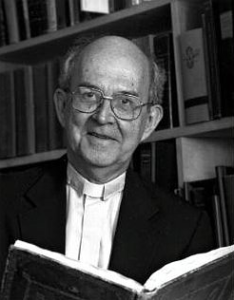Partaking in His Glory (Dr. Ken Bailey)
 Dr. Kenneth Bailey (1930-2016) was an MK and New Testament professor who has spent most of his life in the Middle East. His many books (e.g., Jesus in Mediterranean Eyes) explain the cultural and honor-shame elements of the gospels. This explanation of “partaking in glory” (1 Pet 5:1) is from his latest book The Good Shepherd: A Thousand Year Journey from Psalm 23 to the NT. Dr. Bailey passed into glory 2 days ago at the age of 86.
Dr. Kenneth Bailey (1930-2016) was an MK and New Testament professor who has spent most of his life in the Middle East. His many books (e.g., Jesus in Mediterranean Eyes) explain the cultural and honor-shame elements of the gospels. This explanation of “partaking in glory” (1 Pet 5:1) is from his latest book The Good Shepherd: A Thousand Year Journey from Psalm 23 to the NT. Dr. Bailey passed into glory 2 days ago at the age of 86.
I therefore exhort the elders among you, as the fellow elder and a witness to the sufferings of Christ, as well as a partaker in the glory to be revealed. (1 Pet 5:1)
Here is where the Old Testament Hebrew word for “glory” (kabod) is critical. When we discuss “glory in Scripture (Hebrew or Greek), we are discussing weight and wisdom, not earthly power and wealth. Both Calvin and Luther affirmed theologia cruces (theology of the cross) against what they called theologia gloriae (theology of glory). Their choice of vocabulary was appropriate for their time, but was not helpful for us. The true glory of God shines forth through the weakness and suffering of the cross. The “glory theology” the Reformers discussed had to do with the wealth, splendor and power of the emperors and kings. This they rightly rejected. The same “glory theology” is still with us. Its message now is “if you become a true Christian you will acquire wealth.” In the circles this twisted view, such thinking is still popularly called “glory theology,” and it takes its definition of glory from contemporary (American) culture, not from the kabod (weight/glory) of the Old Testament and New Testaments.
Peter is saying that he was a witness (martys) to the suffering of Jesus and a partaker/partner (koinonos) in the glory (of Christ). In short, Peter saw Jesus suffer painful rejection, and also saw how Jesus responded to that rejection. As a member of the apostolic band, Peter was united with Christ in that suffering. …
The movement in Scripture from suffering to glory (weight) can be traced as follows. The glory/presence/gravitas of God dwelt uniquely in the temple. Jesus was the new temple and the disciples saw the glory of God shining through his suffering. Through baptism and faith they were united with him, and his life produced in them the power to reprocess their suffering to glory/gravitas. Thus 1 Peter 5:1 points to an open door through which the elders were encouraged to enter. Peter watched how suffering for Jesus evoked grace/glory/gravitas. Indeed, Peter “participated” with Jesus in that suffering. He felt the pain of Jesus as his rejection and knew that through Jesus all believers could transform their suffering as did he. A classical biblical image for this transformation is that of the good shepherd who risks his life daily, enduring many hardships and even losing his life for his sheep. The good shepherd must provide wisdom and fearless leadership for the flock as he faces and overcomes heat and cold, wind and rain, ravenous wolves and ruthless thieves. The end result is a good/beautiful/noble shepherd. It is that image that Peter here invokes. When John wrote, “We have seen his glory” (Jn 1:14) he was not denying the future glory (wisdom/gravitas) to be revealed at the end of history. But his focus was on a present reality in which they had participated.
______________
Read more in this series, “Honoring Theology“:
Taken from The Good Shepherd by Kenneth E. Bailey. Copyright (c) 2014 by Kenneth E.Bailey. Used by permission of InterVarsity Press, P.O. Box 1400, Downers Grove, IL 60515-1426. www.ivpress.com

Thanks for bringing Ken Bailey’s passing to our attention. He is far and away my favorite author. If there is one of his books I would recommend, it is “Jesus Through Middle Eastern Eyes.”